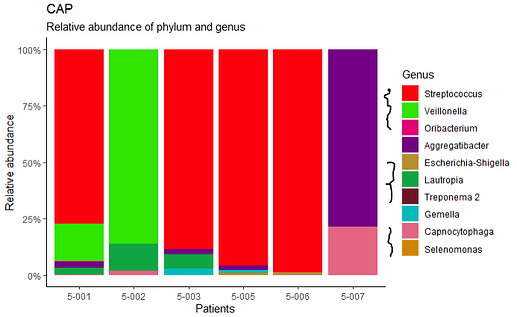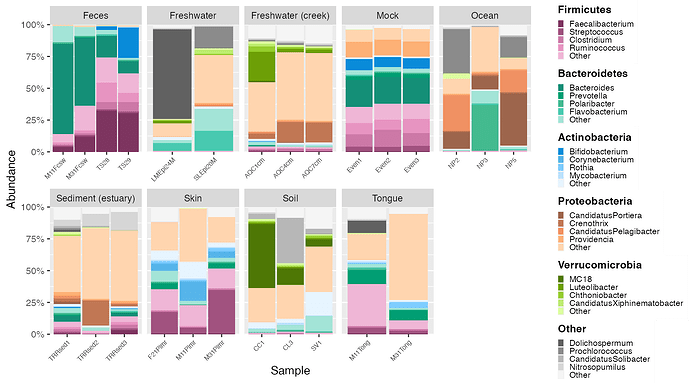HI, Im want make better the legend()
I am looking for the legend to be grouped according to a higher classification (phylum) but that at the same time the genus (Genus) is shown.
I want to have something like that:
Im run this code
ggplot(d4) +
geom_bar(aes(x=Pacientes, y=`Relative abundance`,fill=Genus), position="fill", stat="identity") + scale_x_discrete("Patients") +
scale_y_continuous("Relative abundance",labels=scales::percent) +
labs(title = "CAP",subtitle = "Relative abundance of phylum and genus") +
theme_classic() +
scale_fill_manual(values=c ("#FC000D", "#30E500", "#E10072", "#730183", "#B58E2C","#10A542","#6C1429",
"#00B9B9", "#E36582","orange3","#800009",
"#5E230B","#CC6187","#949285","#FF6A00",
"#FF9D69","#B08A04","#005A3F","#120A5F","#E7BECD"))
d4<-structure(list(Pacientes = c("5-006", "5-005", "5-005", "5-001",
"5-003", "5-002", "5-001", "5-001", "5-005", "5-001", "5-003",
"5-003", "5-007", "5-006", "5-003", "5-001", "5-002", "5-003",
"5-002", "5-002", "5-001", "5-002", "5-003", "5-005", "5-002",
"5-001", "5-006", "5-005", "5-007", "5-005"), Filum = c("Firmicutes",
"Firmicutes", "Firmicutes", "Firmicutes", "Firmicutes", "Firmicutes",
"Firmicutes", "Firmicutes", "Proteobacteria", "Proteobacteria",
"Proteobacteria", "Proteobacteria", "Proteobacteria", "Proteobacteria",
"Proteobacteria", "Proteobacteria", "Proteobacteria", "Proteobacteria",
"Spirochaetes", "Spirochaetes", "Spirochaetes", "Spirochaetes",
"Firmicutes", "Firmicutes", "Bacteroidetes", "Bacteroidetes",
"Bacteroidetes", "Bacteroidetes", "Bacteroidetes", "Firmicutes"
), Genus = structure(c(1L, 1L, 1L, 1L, 1L, 2L, 2L, 12L, 13L,
13L, 13L, 13L, 13L, 14L, 15L, 15L, 15L, 15L, 20L, 20L, 20L, 20L,
21L, 21L, 25L, 25L, 25L, 25L, 25L, 26L), .Label = c("Streptococcus",
"Veillonella", "Haemophilus", "Actinobacillus", "Serratia", "Fusobacterium",
"Neisseria", "Moraxella", "Abiotrophia", "Granulicatella", "Actinomyces",
"Oribacterium", "Aggregatibacter", "Escherichia-Shigella", "Lautropia",
"Geobacillus", "Leptotrichia", "Johnsonella", "Campylobacter",
"Treponema 2", "Gemella", "Megasphaera", "Atopobium", "Bifidobacterium",
"Capnocytophaga", "Selenomonas", "Mycoplasma", "Porphyromonas",
"Alloprevotella", "Lachnoanaerobaculum", "Eikenella", "[Eubacterium] brachy group",
"Stomatobaculum", "Atopostipes", "Selenomonas 3", "Kingella",
"Dialister", "F0058", "Parvimonas", "No identificado", "Solobacterium",
"Otros finales", "Olsenella", "Filifactor", "Rodentibacter",
"Alloscardovia", "Otros", "[Eubacterium] yurii group", "Anaeroglobus",
"Staphylococcus", "Ruminococcaceae UCG-014", "Lactobacillus",
"Rothia", "Selenomonas 4", "Scardovia", "Fluviicola", "Cardiobacterium",
"Bilophila", "Simonsiella", "[Eubacterium] nodatum group", "Catonella",
"Peptoniphilus", "uncultured", "Shuttleworthia", "Butyrivibrio 2",
"Peptostreptococcus", "Mogibacterium", "Bergeyella", "Peptococcus",
"Faucicola", "Blautia", "Rikenellaceae RC9 gut group", "Eggerthia",
"Desulfobulbus", "Tannerella", "Lactococcus", "Prevotella", "Otro",
"Prevotella 7", "Erysipelotrichaceae UCG-006", "Defluviitaleaceae UCG-011",
"W5053", "Craurococcus", "Dolosigranulum", "Sneathia", "Anaerococcus",
"Pseudoramibacter", "Family XIII UCG-001", "Ruminococcus 2",
"Howardella", "Cryptobacterium", "Listeria", "Pantoea", "Akkermansia",
"Prevotella 6", "Macrococcus", "Paracoccus", "Comamonas", "TM7 phylum sp. oral clone FR058",
"Peptoanaerobacter", "Rubellimicrobium", "Fastidiosipila", "Brachymonas",
"Candidatus Tammella", "Slackia", "DNF00809", "Truepera", "Finegoldia",
"Erysipelotrichaceae UCG-004", "uncultured bacterium", "Bulleidia",
"Flexilinea", "Methylobacterium", "Propionivibrio", "Ochrobactrum"
), class = "factor"), `Relative abundance` = c(1.797989737427,
1.17051056033446, 0.967773967968912, 0.890190018788368, 0.875168325944855,
0.203636768715721, 0.190978038791412, 0.0011814814596022, 0.0411830680204194,
0.031674955321716, 0.018003527003462, 0.00559797167763897, 0.0032912697803204,
0.0189880948864639, 0.0386794525465004, 0.0337566131314913, 0.0279054668553661,
0.0242766309437308, 0.000168783065657456, 0.000112522043771638,
8.43915328287282e-05, 8.43915328287282e-05, 0.0290306872930825,
0.0263020277316203, 0.00458527328369423, 0.00393827153200732,
0.00351631386786368, 0.00210978832071821, 0.000900176350173101,
0.021744884958869)), row.names = c(NA, -30L), class = c("tbl_df",
"tbl", "data.frame"))
The grouping colum is Filum and the normal legend is Genus in the data
Thanks


